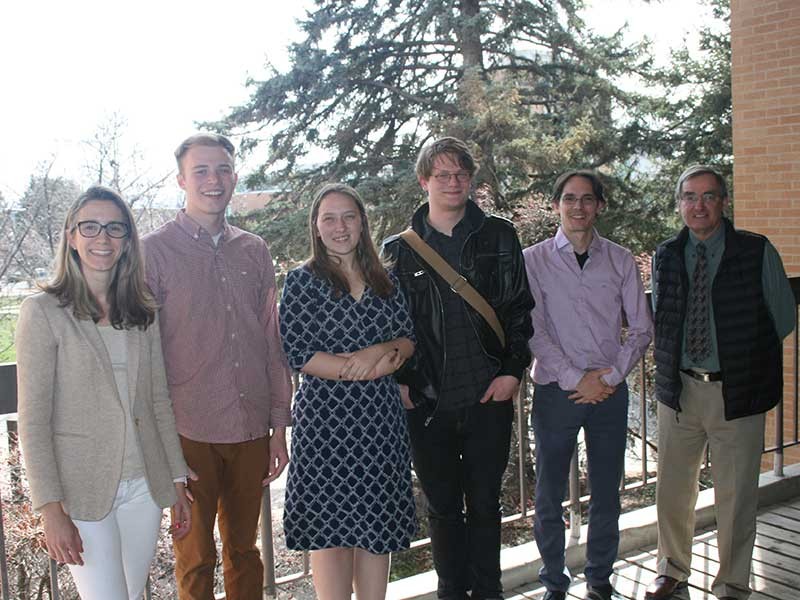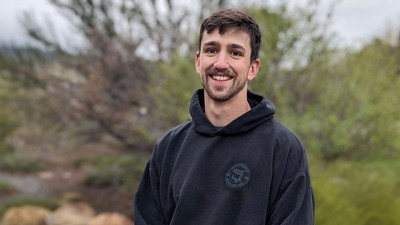In Einstein's Steps: USU Undergrads Study Gravitational Physics in Germany
From left, USU Assistant Professor Maria Rodriguez, USU student David Maughan, Max Planck Professor Harald Pfeiffer and USU students Josh Hibbard and Hope Marks gather in an atrium, featuring a sculpture of Einstein, at Germany's Max Planck Institute.
While traveling to Europe, Utah State University undergrads Josh Hibbard, Hope Marks and David Maughan quickly learned about black holes: That’s where your luggage goes when your transatlantic flights get cancelled and you’re re-routed on an unexpected path. Just kidding!
While the Aggies’ itineraries met some abrupt twists and turns, Marks achieved a remarkable sprint across Paris’ de Gaulle Airport and Hibbard and Maughan had some “wearing-the-same-clothes-in-a-row” days, the scholars arrived safely and mostly soundly at the renowned Max Planck Institute for Gravitational Physics in Potsdam, on the outskirts of Berlin, Germany.
The USU trio was among just 40 students from around the world selected to participate in the prestigious Jürgen Ehlers Spring School 2018 – JESS2018 – held March 5-16.
“This is a chance-of-a-lifetime opportunity for physics students at the world’s flagship institute for gravitational physics, which is also known as the ‘Albert Einstein Institute,’” says USU Department of Physics faculty member Oscar Varela, who helped to arrange the trip with fellow faculty member Maria Rodriguez.
Rodriguez served as a JESS2018 organizer and instructor for the two-week school that offers an intensive introduction to general relativity, black holes, astrophysics and gravitational waves.
With support from USU Physics department head Jan Sojka, Rodriguez and Varela endeavored to raise funds to cover the students’ travel costs, ultimately securing a $10,000 grant from the Max Planck Society.
“Initially, we thought we could get funding for two students, but we were able to support three,” Rodriguez says. “We were thrilled, because this is truly a unique and outstanding experience for students.”
The trip came at a particularly opportune time in gravitational physics, she says, with the 2016 detection of Einstein’s predicted gravitational waves and subsequent developments in the field.
“This is a very exciting time for science,” Rodriguez says.
Hibbard, Marks and Maughan agree.
“The data researchers are collecting reveals insanely powerful electromagnetic fields,” says Hibbard, a 2018 College of Science Dean’s Scholar. “The luminosity coming off of one collision of black holes measures higher than of the stars in the universe.”
Marks says interpreting information from large data sets resulting from gravitational waves data collection is a monumental challenge.
“Recent discoveries are driving new ways of handling the information overload,” she says.
Maughan, who received honorable mention in the national 2018 Goldwater Scholars competition, says the networking opportunities created by the gathering were “incredible.” The undergrad secured a coveted internship slot this summer at Brigham Young University.
In daily gatherings, the students join fellow participants from Germany, India, Iran, Italy, Turkey, Romania, Austria, Bosnia and Canada, in tackling complicated equations. Were the Aggies prepared?
“All the participants were pretty much getting nuked,” Hibbard says. “And some of the participants were graduate students. But we spent hours studying together. It was ‘geek overload.’”
Beyond the institute, the students ventured to Berlin’s Brandenburg Gate and the remains of the Berlin Wall, as well as tours of Kaiser Wilhelm Memorial Church and Potsdam’s many palaces and parks.
A favorite stop was Albert Einstein’s country home in Caputh, where the famed physicist lived from 1929-1932 and formulated many of his famous theories, before fleeing the Nazi-controlled nation for the United States.
“I took a photo of the view from Einstein’s desk, because I wanted to look at what he looked at as he thought about all those big questions,” Hibbard says.
All of the USU participants report the trip was “excellent” and a journey they’d make again in a heartbeat.
“It was great working with students from around the world, hearing all the different perspectives, learning what other students’ university experiences are like and talking about physics,” Hibbard says. “We made great friends and we’re all staying in touch through social media.”
Related Links
“USU Physics, Math Scholar Receives Goldwater Honorable Mention,” Utah State Today
Jürgen Ehlers Spring School, Albert Einstein Institute, Germany
USU Department of Physics
USU College of Science
Contact: Maria Rodriguez, 435-797-8838, maria.rodriguez@usu.edu
Writer: Mary-Ann Muffoletto, 435-797-3517, maryann.muffoletto@usu.edu
Back at Utah State, USU physicists, from left, Maria Rodriguez, David Maughan, Hope Marks, Josh Hibbard, Oscar Varela and Jan Sojka, gather to hear about the students' trip to Germany’s Jürgen Ehlers Spring School.
TOPICS
Hands-on Learning 205stories Physics 99stories Study Abroad 46storiesComments and questions regarding this article may be directed to the contact person listed on this page.








